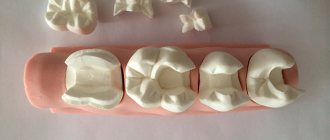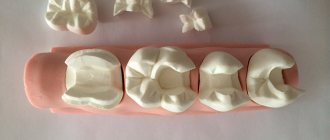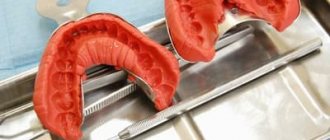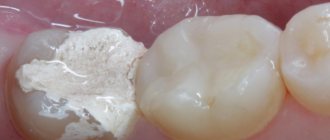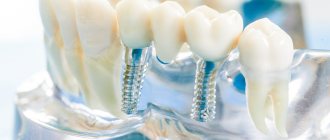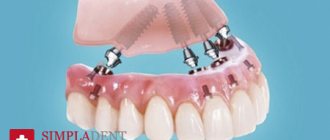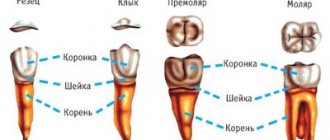In modern dentistry, there are many different methods for restoring damaged teeth - filling, prosthetics, installing inlays. The first two technologies are well known to patients, but few people know that teeth can be successfully restored with inlays.
What are tooth inlays, how do they differ from regular fillings, and in what cases is the use of inlays indicated? We will answer all these questions in detail in this article on our website.
What is it - a tooth tab?
Dental inlays are microprostheses that can be used for different purposes. Restorative or restorative inlays are used like fillings: they help recreate the natural crown of a tooth, keeping it alive. Stump inlays are used in cases where it is necessary to restore a badly damaged tooth under a crown. Let's take a quick look at why restoration and stump inlays are used, and find out the difference between them.
Restoring inlays are stronger than conventional dental fillings and differ from them in the technology of their creation: dental inlays are not made directly in the patient’s mouth, like fillings, but in a dental laboratory, using previously taken impressions. Because microdentures are made in a laboratory setting, they are also called indirect dental inlays.
The inlays exactly repeat the shape of the cavity that needs to be closed for tooth restoration and fit tightly to the natural tissues. The high density of adhesion of the inlay to the tooth tissue eliminates the risk of developing caries in the gap between the installed microprosthesis and the tooth. Restoring a tooth with an inlay will help keep the tooth alive in a situation where a sufficient amount of tooth tissue has been preserved, its nerve is alive and well, but a large filling still needs to be placed. Large fillings do not stick well to the teeth and can break under stress, along with the tooth. Inlays have a long useful life, can withstand chewing loads well, and their use makes it possible not to rush into dental prosthetics with a crown, which often requires preliminary depulpation of teeth.
Stump inlays for a tooth are no longer a restoration element, but a technical one. It acts as a support for the installation of a dental crown in cases where the tooth cannot be restored qualitatively with a conventional filling. In order not to confuse stump and restoration inlays, the easiest way to classify them is as follows: restorative inlays are installed outside the living tooth, stump inlays are always located under the crown.
This is the main classification of inlays, but they can also differ in the type of material they are made of, and below we will definitely talk about all the types of microprostheses and their features. But first, let's find out who and when is recommended to install inlays on teeth.
Classification by materials
Regarding how and from what inlays for crowns are made, there is a choice: composite, ceramics, zirconium or metal (an alloy of cobalt and chromium). Each type has its own advantages and disadvantages and indications for installation. Therefore, the decision regarding the choice of one or another type of design is made by the doctor, taking into account the characteristics of the clinical picture. Let's consider popular materials used to create microprostheses.
Composite Tabs
Composite structures are usually based on a metal pin lined with a polymer. Thanks to the durable frame, the restoration copes better with chewing loads, but compared to other types of inlays it still does not provide the required degree of strength and reliability. But the material adheres tightly to hard tissues, which virtually eliminates the formation of gaps in which bacteria could accumulate and provoke pathological processes. Another important advantage is the ability to repair the product directly in the patient’s mouth, that is, using the direct method.
A composite inlay makes it possible to restore teeth directly in the mouth
Estimated cost in Moscow – 6,000 rubles.
Ceramic products
Ceramic products are indicated for the restoration of the smile area - they preserve aesthetics better than others. Ceramics, which is widely used in prosthetics today, has similar external characteristics to natural enamel. It eliminates the risk that over time the stump will begin to show through the crown or at the junction of the prosthesis with the mucosa. However, the material is not strong enough to be used to restore posterior teeth.
Ceramic products are indicated for the restoration of the smile area
The approximate cost of installation is 12 thousand rubles.
Zirconium structures
The material combines high strength and aesthetics. Zirconium dioxide has a white color, which in terms of transparency almost completely matches natural enamel. Such a stump will not show through the crown, but will provide the required degree of strength and reliability of the entire structure, even in the area of the chewing teeth. This is the best solution for the restoration of the smile area, where serious demands are placed on aesthetics in the long term.
Zirconium dioxide inlays will not show through the crown
The cost of installation in Moscow is about 15 thousand rubles.
Metal artificial stump
As for what metal the inlays for crowns are made of, there is a small choice. The most common and budget option is an alloy of chromium and cobalt. It is also possible to install a stump made of gold and silver, but for this, the dental clinic must have the appropriate permit to work with precious metals. There are similar products made of titanium - they are very strong and reliable, but if such a structure suddenly breaks, it will not be so easy to get it. In general, metal products are quite strong, but unaesthetic, so they are used to restore chewing teeth.
Metal products are used to restore chewing teeth
Approximate prices – 4,000 rubles. for a tooth with 1-2 roots and 5,000 rubles. for restoration taking into account 3 roots or more.
Indications for dental restoration with inlays
Let's look at all the cases in which the use of tabs may be indicated. It is recommended to use tabs:
- If the tooth is destroyed by more than 1/3;
- With increased wear of chewing teeth;
- When restoring teeth that in the future will have to act as a support for a crown or installation of a bridge;
- For large carious cavities in the teeth, the elimination of which with conventional fillings is ineffective.
The need to use inlays is determined by the dentist during the examination of the patient. Based on the clinical situation, the specialist will choose the type of microprosthesis that is suitable for you, both in terms of functionality and material of manufacture.
Conditions for installing tabs:
- Inlays are used even with a high degree of tooth decay - more than 50%. It is better for such a tooth to be vital, that is, non-pulpless - with a living nerve.
- Ceramic inlays are installed only on chewing teeth (molars and premolars). The shape of the canines and incisors does not allow them to be restored in this way.
- The tab can be installed in the absence of one, two or even three walls. However, its use involves supragingival preparation, so the walls should not be absent to the very edge of the gum.
- To install the structure, sufficient thickness of the tooth walls is required. If they are very thin, they will quickly break. In such a situation, it is generally better to remove the wall and restore it with a tab.
Types of restoration dental inlays: description, characteristics
In this section of the article, we will tell you about what restoration dental inlays can be, used in tooth restoration as an alternative to conventional fillings. Prostheses will be classified mainly according to the material of manufacture and according to this criterion, the inlays can be ceramic, composite, or metal. The material of the tooth inlay will affect both the performance characteristics of microprostheses and their cost.
Ceramic tooth inlay and its features
Most often, ceramic dental inlays are used to restore chips on living teeth and act as a high-quality and more reliable alternative to conventional fillings.
Ceramic inlays can only be placed on teeth that are alive, not loose, and have been treated for caries. Ceramic dental inlays have many advantages: they are aesthetically pleasing, durable, do not change their beautiful color even with prolonged use, and do not wear off. The high density of the marginal contact of the ceramic inlay with the natural tissues of the tooth eliminates the risk of developing secondary caries.
But ceramic dental inlays have some disadvantages. Some consider the disadvantages of ceramic inlays for teeth to be the high price of this type of microprosthesis in Moscow (from 8 thousand rubles), however, it should be noted that the high cost is fully justified by the long service life of ceramic inlays and their impeccable aesthetics. Please note that with ceramic inlays installed on your teeth, you will need to give up the habit of chewing nuts, crackers, and other types of too hard foods with your teeth. The ceramic inlay may not withstand such heavy loads!
Metal tooth tab: characteristics, pros, cons
Metal restoration inlays are used quite rarely these days, and all because microprostheses made from this material have a number of disadvantages:
- When installing metal inlays in the mouth, a very unpleasant galvanic side effect for the patient may occur, expressed in constant and profuse salivation, a pronounced metallic taste in the mouth;
- Installing metal inlays does not allow for high-quality and tight contact between the microprosthesis and the natural tissues of the tooth, and this increases the risk of developing secondary caries. Gold inlays on teeth can provide a good fit, but their price will be high, because gold is a noble and expensive metal;
- Metal inserts can cause allergic reactions;
- The aesthetics of metal inlays also leaves much to be desired.
The only significant advantage of metal inlays for teeth is the fairly low price for this type of microprosthesis in Moscow. The cost of a metal tab in the capital’s clinics starts at 4,000 rubles for one orthopedic product.
Composite inlays for teeth
Composite inlays are used to restore single-rooted teeth, which include incisors and canines, that is, the front teeth included in the smile area.
Installation of a composite inlay can only be carried out if the tissue in the tooth being restored is preserved in a volume of at least 50%. Composite inlays are also called pin inlays because when they are placed in the tooth canal, a pin is first placed on which the dentist will apply the composite material in layers. If the tooth is severely damaged, installing an inlay on a pin is not recommended, since over time the pin may begin to wobble in the tooth canal and its mobility can lead to a fracture of the tooth root. If your tooth is more than half destroyed, you do not need a restoration, but a stump inlay followed by installation of a crown!
How much will a composite tooth inlay cost? The answer to this question will depend on what type of post and composite material the dentist uses during the restoration process.
The price of a restoration insert will also depend on the method of its manufacture. All inlays, except composite ones, are created in the laboratory using dental impressions. The tooth for the inlay must be ground down, although the volume of tissue removed will be less than the amount of dental tissue that is removed for the crown. The most complex manufacturing technology is for ceramic crowns, which are made from pressed ceramics: they are created using CAD/CAM computer technology. The complexity of the technology increases the price of ceramic inlays, but such microprostheses will have high anatomical accuracy, which means they will last longer.
What are the pros and cons?
Prosthetics using this method has many undeniable advantages, providing a more reliable and long-term result than a single prosthesis supported by a pin. Here are just the main advantages:
- strength of the entire structure and long-term result - the risk of fracture is significantly lower than in the case of a pin,
- a large area of contact with living tissues, which ensures a more correct distribution of the chewing load and reduces the risk of rapid destruction,
- the patient can participate in the choice of material, but taking into account the location of the element being restored,
- monolithic structure can be replaced if it breaks,
- Such prosthetics allows not only to restore a damaged tooth, but also to correct the bite.
The design is quite strong and reliable.
However, there are some disadvantages. Firstly, treatment requires several visits to a specialist, since the structure itself is made from impressions in a separate laboratory, and this inevitably prolongs the time for prosthetics. Secondly, the cost of treatment will be an order of magnitude higher than in the case of installing a prosthesis on a live ground tooth or on a pin.
How are restoration inlays installed on teeth?
Installing a restorative inlay on teeth is a multi-step process that always begins with a detailed diagnosis, which will include examination, radiography and computed tomography. After the diagnosis, the type of inlay is selected and a detailed treatment plan is drawn up.
The tooth on which the inlay is planned to be placed is ground down and then an impression is taken from it and sent to a dental laboratory. An inlay will be made based on the impression and the average production time is 5-7 days.
When the inlay is ready, the patient is invited to the clinic for fitting and installation of a microprosthesis. The inlay is fixed in the tooth cavity using special dental cement.
Manufacturing nuances
The manufacturing process includes several important steps. First, it is necessary to take impressions as a basis for creating the product in a separate laboratory. The doctor forms a cavity in the tooth for the structure and makes a cast of refractory wax. First, he isolates the work area using a rubber dam. Then he warms up the wax stick and carefully inserts it into the formed cavity so that excess wax comes out. The patient is then asked to close their jaws to make an impression.
Next, the orthopedist uses a special spatula to model the external contours, after which he heats a small piece of thin wire and inserts it into the wax cavity. The composition is cooled with a stream of water and the model of the future product is carefully pulled out by the tip of the wire1. The wax prototype is plastered in the laboratory, and a finished product is created based on the resulting model.
Is it possible to put an inlay on the front teeth?
Inlays are not used for the restoration of anterior teeth. If there is a sufficient amount of healthy tooth tissue, the tooth is restored with a regular filling and then a veneer or lumineer can be placed on it to obtain a beautiful aesthetic restoration in the smile area. If the tooth is severely damaged, then it makes sense to install a stump tab and then a crown.
The traditional area of application for restoration inlays is chewing teeth.
When prosthetics are contraindicated
Contraindications to prosthetics with metal stump inlays include the following factors:
- presence of pulp in the roots: first the tooth should be completely depulped, i.e. remove the dental nerve,
- cracks in the roots
- cysts and granulomas under the roots,
- the roots have previously been resectioned: i.e. their lower parts have been removed, in other words, the root is too short,
- severe tooth mobility (3rd degree, and in some cases 2nd),
- The root canals are strongly curved and difficult to pass: this makes it difficult to pass them when removing the nerve, so there is a risk of secondary caries or pulpitis, as well as periodontitis under the prosthesis.
Can a tooth get sick under an inlay and what to do if this happens?
If the tooth under the inlay hurts, you need to urgently contact a dental clinic, because pain under the installed microprosthesis can indicate the development of various kinds of complications. The main cause of complications after installing an inlay is medical errors that were made during the treatment process, and that is why it is so important to choose dentistry carefully! If, when treating a tooth, the doctor allows the pulp to overheat, an inflammatory process may begin, as a result of which the tooth under the tab will become sore. To eliminate pulpitis, you will have to remove the tooth inlay, receive appropriate treatment, and then restore the tooth again, possibly with a prosthetic crown or even implantation.
Inlays are often placed on teeth after caries treatment and it is extremely important that when working with a carious cavity, the dentist removes all destroyed tissue. If this is not done, secondary caries will begin under the tab, the treatment of which will again require removal of the tab.
Remember that if 5-7 days have passed after installing the inlay on the tooth, and your tooth hurts and the intensity of the pain is increasing, you need to urgently see a dentist, and not try to solve the problem yourself! If the infection gets into the root part of the tooth, it is not always possible to save the tooth and avoid its removal!
If the tooth does not hurt, but you have the feeling that it is bothering you - when eating, talking, trying to close your teeth - contact the clinic where you received the inlay to have its size corrected.
Types and their design features
Such products can be either integral or collapsible. Each type is designed for installation according to specific indications. Let's look at them a little more closely:
- collapsible stump - used if you have to work with three or more roots. In such a situation, a cast microprosthesis may not be suitable, since an individual approach to solving the problem is required. This model is more expensive than a cast model, and once installed it is no longer possible to remove it,
- conventional stump – is a one-piece microprosthesis, one part of which is fixed in the root canals, and the second serves as a support for the restoration. This is a more budget-friendly, but no less reliable option, which is suitable for restoring teeth with 1-2 roots.
Stump inlays are either collapsible or integral.
Similar orthopedic products can be made of different materials. The choice of a specific model depends on the location of the diseased tooth and the individual characteristics of the clinical picture.
Stump inlays: what do you need to know about them?
At the very beginning of our article, we said that stump inlays should not be confused with restorative microprostheses - they are used to restore pulpless and severely damaged teeth, in which they will serve as the basis for installing a crown or dental bridge.
Stump inlays are structures consisting of two parts: a pin installed in the root canal and a support on which the crown will be fixed. Stump inlays can be monolithic or collapsible, and most often this type of structure is used when the tooth has less than 50% of healthy tissue left.
Many people are interested in the question: why is it best to use core inlays rather than fillings on a pin to restore severely damaged teeth? The fact is that the pin may not withstand the load and begin to wobble in the canal, and this will either lead to the filling breaking or falling out, or, worst of all, to damage to the tooth root, in which the tooth is most often removed. Stump inlays allow you to avoid such risks because they distribute the load more correctly and themselves have much greater strength compared to pins.
Stump inlays are also made in the laboratory and the construction material is selected to match the type of dental crown that is planned to be placed in the future. Metal core inlays are used for metal-ceramic crowns, and zirconium inlays are used for ceramic crowns. If you make a metal inlay for a ceramic crown, it can shine through the thin and transparent material of the crown, which will have a bad effect on the aesthetics of the restoration.
Tooth restoration using a core inlay will also be divided into several stages: diagnostics, preparation, during which a cavity is formed in the tooth for the inlay, manufacturing of the inlay, and its installation. After installing the core tab, the crown is fixed on it and this completes the process of tooth restoration.
If the tooth is destroyed, but there is a living nerve in it, before installing the stump tab, depulpation is carried out, as well as treatment and filling of the root canals. It is important that these procedures are carried out without errors, since poor canal processing leads to various kinds of complications, the elimination of which requires complex and lengthy treatment.
What are the alternatives?
If there is a volumetric lesion of the coronal part of the tooth, there are only four options for prosthetics. The first is the tabs themselves. The second is filling, but a large filling may not withstand the load, and there will be too few tooth walls for the composite material to adhere to, so it will be short-lived. The third method is to install a crown. But this option is an extreme option, when other methods are no longer effective. The fourth method is tooth restoration on a pin: a metal rod is installed inside the root, which serves as a support for restoring the coronal part (using an artificial crown or composite build-up). This option is cheaper, but less durable, and the pin can lead to root fracture.
1 Shcherbakov A.S., Gavrilov E.I. Orthopedic dentistry. Ed. Folio, 1998.
Tab lifespan
The service life of restoration inlays will depend on the material and production technology of microprostheses, as well as on how accurately the patient follows the dentist’s recommendations. Composite inlays last about 5-7 years, ceramic inlays - up to 20 years. This is subject to high-quality dental and oral hygiene and regular visits to the clinic for preventive examinations.
Stump inlays can last you a lifetime, and crowns on them last up to 15-20 years.
Do you still have questions about restorative and core dental inlays? Ask them to the orthopedists of our dentistry in Moscow - Vanstom! You can make an appointment with the clinic’s doctors at any time convenient for you - through the chat on our website, the call back form, or simply by dialing the contact phone number!
How long will the restoration last?
In this matter, much depends on the initial characteristics of the clinical picture and the material from which the product is made. If at least one of the walls of the living crown is preserved and all medical manipulations were performed correctly, then such a restoration can last 10 years or more - this applies to zirconium and metal.
In the case of ceramics and composites, the service life may be slightly shorter, which is explained by the fragility of the materials. However, such products are usually used as part of the restoration of the smile area, so in the absence of intense chewing load, they will last no less than their counterparts made from more durable materials. Proper care and proper prevention will help maximize the service life of products.
This type of restoration can last 10 years or more.
Indications and contraindications
The main reason for installing an inlay is significant destruction of a normal tooth by caries. In this case, more than half of the hard tooth tissue is lost. In essence, an inlay is an extra-large (on the scale of a tooth) filling that solves a problem that in this case cannot usually be corrected with a filling.
Other indications may be: wedge-shaped damage, trauma, large and frequent chips that damage the tooth, thinning of the enamel, loss of dental tissue, installation of crowns, bridge prosthetics. One of the “painless” reasons is that the patient has noticed accelerated wear of the enamel, but the tooth does not yet hurt.
The reasons why it is better to refuse the installation of an inlay are minor caries, piecewise linear tooth relief that goes deep into the dentin (where the enamel can be weakened in advance), rapidly growing caries, insufficiently regular and frequent cleansing of the mouth from food debris, grinding teeth in sleep .
Cost of dental prosthetics
The price of a metal tooth insert depends entirely on the cost and weight of the metal from which it is made, as well as on the complexity and method of production.
For example, a cast one-piece structure made of cobalt-chrome alloy for a single- or double-channel tooth costs an average of 5,000 rubles, a collapsible one (more than 2 roots) - from 6,000 rubles. The price of milled products (titanium, for example), as well as cast structures made of precious metals is about 12-15 thousand rubles. But do not forget that the full cost of prosthetics will also take into account the preparation of the tooth and the manufacture of a crown, which costs 10-20 thousand rubles, depending on the material. 1Abakarov S.I. Microprosthetics in dentistry, 2022.
Wearing and care tips
In order for the restoration to serve for many years without problems and complaints, you need to properly care for it. To do this, it is necessary to carry out high-quality oral hygiene - brush your teeth and dentures twice a day with a brush and paste, and rinse your mouth with clean water after each meal or use an irrigator. It is also important not to overload the orthopedic structure with excessively hard food, not to chew nut shells and seeds, and not to open the lids with your teeth. And you definitely need to visit your dentist 2 times a year for preventive maintenance - after all, not all pathological changes are noticeable to an unprofessional eye.
PROSTHETIC PROSTHETICS WITH 4 STRAUMANN IMPLANTS “teeth in 1 day” - RUB 220,000. until January 15, 2022!
Complex implantation using ProArch technology (Switzerland) with immediate loading on the day of surgery!
Call now or request a call
If discomfort suddenly appears - it seems that the prosthesis is wobbly, there is pain under the crown, there is bleeding gums, bad breath, then this is a reason for an unscheduled visit to an orthopedist.
Stages of manufacturing and prosthetics
First, the orthopedic dentist conducts diagnostics, incl. and x-ray examination to assess the condition of the roots and surrounding bone tissue. If there are no contraindications, then preparation for prosthetics begins (this can be done by a dentist):
- the old filling is removed (if any),
- carious areas of enamel and dentin are carefully removed,
- the pulp is removed,
- The canals are thoroughly processed followed by filling.
Then the work of the orthopedic dentist begins, who grinds down the walls of the tooth, giving them the correct slope, and also slightly unfills the root canal (to the length of the lower part of the future inlay). After this, wax impressions are taken, from which a model is created in the laboratory - and on its basis, a real stump inlay is made. All this time the patient walks with a temporary filling or temporary prosthesis. How to install a metal inlay in a tooth? After the structure is made, it is tried on and, if there are no inaccuracies, fixed with permanent cement.
But the prosthetics are not completed yet. Next, impressions are taken again. These can be either classic impressions or intraoral 3D scanning, from which a permanent crown is made - metal-ceramic or zirconium (more precisely, zirconium dioxide) or another prosthesis, under which a metal inlay will stand. While the prosthesis is being created in the laboratory, the patient is fitted with a temporary crown made of acrylic or composite. Thus, the entire prosthetic process can take about 2-3 weeks - it all depends on the workload of the dental laboratory.
